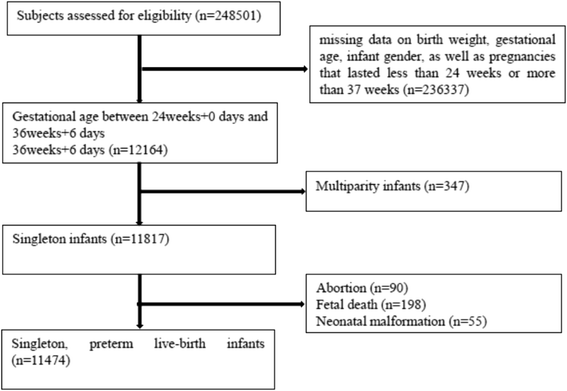The prevalence and risk factors of preterm small-for-gestational-age infants: a population-based retrospective cohort study in rural Chinese population
- PMID: 28728571
- PMCID: PMC5520343
- DOI: 10.1186/s12884-017-1412-7
The prevalence and risk factors of preterm small-for-gestational-age infants: a population-based retrospective cohort study in rural Chinese population
Abstract
Background: Preterm birth and small for gestational age (SGA) are strong indicators of neonatal adverse outcomes. With the growing importance of preterm SGA infants, we aim to evaluate the prevalence and risk factors for preterm SGA in China.
Method: We analyzed the data of parents and infants from a population-based cohort research of the free National Pre-pregnancy Checkups Project (NPCP) in rural China. Only singleton live births that occurred between 24 weeks +0 days and 36 weeks +6 days of pregnancy were included in this study. SGA was defined as birth weight less than the 10th percentile of the reference birth-weight-for-gestational-age population. A multiple logistic regression model was built using the statistically significant variables from the 371 variables in the questionnaire.
Results: A total of 11,474 singleton, preterm, live-birth infants were included. Of the total infants, 317 (2.77%) were preterm SGA infants. A higher risk of preterm SGA infants was observed among mothers who were on oral contraceptives (OR: 8.162, 95% CI: 1.622-41.072), mothers who had syphilis (OR: 12.800, 95% CI: 1.250-131.041), and mothers with a high eosinophil percentage (OR: 13.292, 95% CI: 1.282-135.796). Maternal intake of folic acid at least 3 months before pregnancy (OR: 0.284, 95% CI:0.124-0.654) and paternal intake of egg and meat (OR: 0.097,95% CI:0.030-0.315) were protective factors. Compared with North China, the incidence of preterm SGA infants was higher in South China.
Conclusion: Preterm SGA infants were associated with both maternal and paternal factors.
Keywords: Folic acid supplementation; Oral contraceptive; Preterm delivery; Small for gestational age.
Conflict of interest statement
Ethics approval and consent to participate
The study was approved by the medical ethics committee of the Peking Union Medical College Hospital. Informed consent was obtained from all NFPC participants.
Competing interests
The authors declare that they have no competing interests.
Publisher’s Note
Springer Nature remains neutral with regard to jurisdictional claims in published maps and institutional affiliations.
Similar articles
-
Impact of Periconceptional Folic Acid Supplementation on Low Birth Weight and Small-for-Gestational-Age Infants in China: A Large Prospective Cohort Study.J Pediatr. 2017 Aug;187:105-110. doi: 10.1016/j.jpeds.2017.04.060. Epub 2017 May 22. J Pediatr. 2017. PMID: 28545876
-
Risk factors for small-for-gestational-age and preterm births among 19,269 Tanzanian newborns.BMC Pregnancy Childbirth. 2016 May 17;16:110. doi: 10.1186/s12884-016-0900-5. BMC Pregnancy Childbirth. 2016. PMID: 27183837 Free PMC article. Clinical Trial.
-
Association Between Paternal Age and Birth Weight in Preterm and Full-Term Birth: A Retrospective Study.Front Endocrinol (Lausanne). 2021 Jul 22;12:706369. doi: 10.3389/fendo.2021.706369. eCollection 2021. Front Endocrinol (Lausanne). 2021. PMID: 34367073 Free PMC article.
-
The associations of birth intervals with small-for-gestational-age, preterm, and neonatal and infant mortality: a meta-analysis.BMC Public Health. 2013;13 Suppl 3(Suppl 3):S3. doi: 10.1186/1471-2458-13-S3-S3. Epub 2013 Sep 17. BMC Public Health. 2013. PMID: 24564484 Free PMC article. Review.
-
New Option in the Lives Saved Tool (LiST) Allows for the Conversion of Prevalence of Small-for-Gestational-Age and Preterm Births to Prevalence of Low Birth Weight.J Nutr. 2017 Nov;147(11):2141S-2146S. doi: 10.3945/jn.117.247767. Epub 2017 Sep 13. J Nutr. 2017. PMID: 28904115 Review.
Cited by
-
Folic acid supplementation, dietary folate intake and risk of small for gestational age in China.Public Health Nutr. 2020 Aug;23(11):1965-1973. doi: 10.1017/S1368980019003331. Epub 2019 Dec 2. Public Health Nutr. 2020. PMID: 31787119 Free PMC article.
-
Prognostic factors associated with small for gestational age babies in a tertiary care hospital of Western Nepal: A cross-sectional study.Health Sci Rep. 2021 Feb 15;4(1):e250. doi: 10.1002/hsr2.250. eCollection 2021 Mar. Health Sci Rep. 2021. PMID: 33614985 Free PMC article.
-
Dietary Folate Intake and Folic Acid Supplements among Pregnant Women from Southern Italy: Evidence from the "Mamma & Bambino" Cohort.Int J Environ Res Public Health. 2020 Jan 19;17(2):638. doi: 10.3390/ijerph17020638. Int J Environ Res Public Health. 2020. PMID: 31963813 Free PMC article.
-
Factors associated with small-for-gestational-age births among preterm babies born <2000 g: a multifacility cross-sectional study in Ethiopia.BMJ Open. 2022 Nov 22;12(11):e064936. doi: 10.1136/bmjopen-2022-064936. BMJ Open. 2022. PMID: 36414292 Free PMC article.
-
Prevalence of large-for-gestational-age and macrosomia newborns in South China, 2014-2021: a large population-based cross-sectional study.J Health Popul Nutr. 2025 Jul 12;44(1):253. doi: 10.1186/s41043-025-00959-3. J Health Popul Nutr. 2025. PMID: 40652252 Free PMC article.
References
Publication types
MeSH terms
LinkOut - more resources
Full Text Sources
Other Literature Sources
Medical


